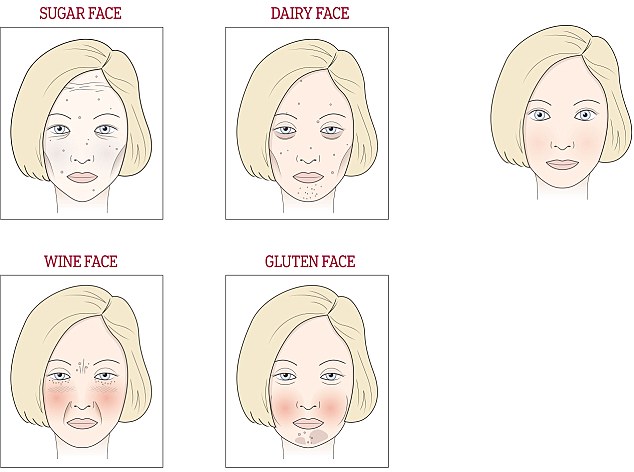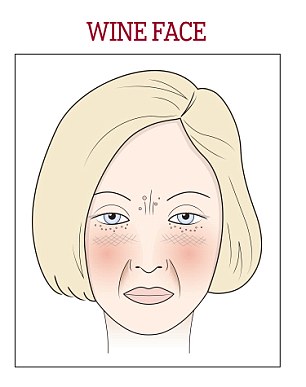

You probably know one too many cocktails leaves your complexion pale and lacklustre, but did you know milky lattes could be responsible for the dark rings under your eyes and the spots on your chin?
Or that your forehead wrinkles or spidery eyebrows could be down to chocolate?
Naturopath and skincare specialist Nigma Talib - who treats celebrities such as Sienna Miller and make-up guru Charlotte Tilbury - is convinced food and drink has a direct and sometimes instant impact on our faces, resulting in recognisable symptoms she identifies as 'dairy face', 'wine face', 'sugar face' and 'gluten face'.

Wine, gluten, dairy and sugar can cause adverse reactions to some people's skin, such as wrinkles
'The second a patient walks into my clinic I can immediately tell the sort of foods they tend to over-eat just by checking the way their face is ageing,' she says.
'In fact, I often find myself reading random faces in the street. I want to run up to strangers and tell them to cut milk out of their diet or hold back on the pasta as it is so clear from their complexion that their diet is doing them harm.
'For some people, just one wheat-heavy day - cereal for breakfast, bread for lunch and pasta for dinner - is enough to cause bloating and puffiness.
'A couple of glasses of wine can trigger fine lines around the mouth and eyes, and - if you are intolerant - a creamy sauce or a piece of cheese might trigger a spotty break-out or dark circles under the eyes.'
Nigma is not the first to believe that your face can give away the truth about your health. Face mapping is a strand of ancient medicine that links parts of the face with specific organs of the body - just as reflexology does with the feet.
And while many contemporary Western practitioners may scoff at this approach, modern skincare brands, such as Dermalogica, have adopted it as a part of their skin analysis programme. Even the most traditional of doctors would admit they can see the legacy of heavy drinking or lack of sleep in someone's skin.

Different substances can have different effects on the face, from spots to swollen eyelids to forehead wrinkles
Over the past ten years, Nigma has seen thousands of patients and has become convinced that what you eat, and its effect on the health of your gut, is fundamental to the way your face ages.
'Any issues with the digestion of certain foods - perhaps you have an unknown intolerance or you eat more of a food than you can comfortably digest - can cause a cascade of chemical and hormonal changes that speed the ageing process internally and externally, with the results swiftly showing on your face,' she says. 'Certain food groups appear to be particularly damaging: gluten, dairy, sugar and alcohol. Each taxes the body in specific ways, contributing to a cluster of ageing symptoms such as spots, puffiness, changes in skin tone, premature fine lines and wrinkles or sagging.
'The part of your face most affected - whether it's your forehead, chin, cheeks or eyes - will depend on the part of the body being put under most stress by the food group.
'It's impossible to be prescriptive about how much is too much as it differs from person to person - your best friend might be able to drink pints of milk without any problem, while for you a smear of butter could trigger a breakout.
'But if you can identify your face problem, you can take steps to eliminate - or avoid as much as possible - the food or drink that is causing it and watch the years slip away.'
Here, Nigma shows you what to look out for - and what to do about it.

Typical symptoms: Pronounced lines or redness between the eyes, droopy eyelids, enlarged pores, dehydrated skin with feathery lines across cheeks, reddish cheeks and nose, deep nasolabial folds.
I call this 'wine face' because these characteristics are so distinctive of women who enjoy a glass or two on most nights of the week, but the truth is these ageing characteristics can be triggered by any kind of alcohol.
Alcohol dehydrates the skin, which worsens the look of fine lines and wrinkles. The deeply ageing nasolabial lines, which run from nose to mouth, can lift and lighten as soon as you stop drinking and become rehydrated.
Alcohol is high in sugar, which damages the protein collagen - vital for keeping skin elastic - causing enlarged pores and droopy eyelids.
According to face mapping, the space between the eyes is associated with the liver, and in my clinic I've noticed women whose livers struggle to process alcohol tend to have deep lines or redness between the brows (another sign of liver stress is a purple hue to the tongue).
Alcohol is known to inhibit the action of the enzyme that the body uses to fight the skin-destroying inflammatory process, so a couple of glasses of wine could be enough to allow the inflammatory process to take over, resulting in highly coloured cheeks and a red nose.
This can be exacerbated by the fact alcohol (like hot drinks and spicy food) can cause the delicate capillaries of the cheeks and nose to dilate, drawing blood to the surface of the skin.
If this happens frequently, they remain enlarged, giving a permanently ruddy appearance.
I recommend taking a short alcohol break (three weeks, to allow your gut to rebalance) then sticking with an 80/20 rule.
Abstain for 80 per cent of the time, but enjoy an odd glass in the other 20 per cent. Choose lower-sugar wines such as sauvignon blanc, pinot grigio, merlot or pinot noir.

Typical symptoms: Lines and wrinkles on the forehead, sagging under the eyes, gaunt look to the face, painful pustular spots all over the face, thinning of the skin, a grey/pasty white hue to the skin.
If your diet is full of sugar and highly refined carbohydrates, such as cakes, pastries and white rice, which quickly convert to sugar in the body, your skin is struggling to stay youthful.
The problem is that sugar triggers a process called glycation, which is when excess glucose molecules attach themselves to collagen, making the normally springy, elastic collagen fibres rigid and inflexible.
This causes the skin to sag and thin, and lines and wrinkles to appear prematurely - particularly under the eyes, where the skin is most delicate and loss of elasticity more apparent.
According to face mapping, the forehead is associated with the process of digestion, which is why 'sugar face' may manifest as blotches or wrinkles on the forehead.
Too much sugar affects fat distribution, too, with sugar lovers ending up with a gaunt appearance because their face loses the fat that should keep it looking plump.
But it's at the gut level that sugar is really disruptive. It has such an impact on the delicate balance of bacteria in the gut that it can trigger pustular acne on the face, shoulders and chest.
And even sugar-dependent patients who don't suffer from acne have noticeably pale, sallow skin. This is due to sugar increasing the levels of the hormone insulin, which can stimulate production of the stress hormone cortisol.
Because cortisol instructs the body to divert energy to more essential tasks, blood vessels around the face constrict, resulting in washed-out skin. Over time, cell turnover can slow down, leading to dull skin.
But one of the most curious signs of sugar addiction can be seen in your eyebrows. Insulin imbalance caused by sugar highs and lows can put undue stress on the adrenal glands which, among other tasks, control eyebrow hair. Eyebrows that have become fine and thin could be a sign of adrenal exhaustion where the overworked glands (which control the stress hormones) start to under-perform.
Cutting back on sugar can have an immediate and lasting impact on your face. For best results, cut out additional sugar entirely, avoiding cakes, biscuits, fruit juices, refined carbohydrates and processed food.
Even if you just cut your intake in half and gradually wean yourself off sugar, you will notice rapid improvements in your complexion.

Typical symptoms: Swollen eyelids, bags and dark circles under eyes, small white spots and bumps on the chin.
Any one of these could be signs that your body is struggling to digest milk and dairy products such as cheese, yoghurt and cream. Lactose in milk is one of the most common food intolerances.
Problems can develop in later life because we lose the enzymes that allow us to digest lactose effectively.
You might notice intolerance as burping or mild nausea after drinking milk. But sometimes your body could be struggling to digest the proteins in milk and you won't have any symptoms.
This could be prompting your immune system to trigger the release of inflammatory chemicals that have an impact on every part of your body, including your skin.
The same inflammatory process that causes redness, swelling and heat around a sprained ankle or splinter, for instance, can trigger puffy eyelids, under-eye bags and dark circles on your face.
And that's not all. A glass of milk can contain a cocktail of more than 20 hormones and chemicals, some of which occur naturally and some which will have been fed to the cow, such as antibiotics, anti-fungals, growth-promoters and painkillers.
These disrupt the balance of your hormones - particularly the so- called 'sex hormones' oestrogen and progesterone - and trigger an over-growth of skin cells which block pores and trap bacteria.
I've found these dairy 'papules' tend to occur around the chin and this makes sense if you look at face mapping, which believes the chin is connected to the reproductive organs. This is thought to be why hormone-influenced spots often cluster on the chin.
If you suspect your facial ageing is dairy-related, I recommend a break from all forms of dairy products for three weeks - the impact on your face can be striking.

Typical symptons: Puffy red cheeks, dark pigmentation patches or spots around chin.
Lots of us are sensitive to gluten - a protein found in wheat, barley and rye. While relatively few suffer from coeliac disease (an auto-immune condition when gluten triggers the body to attack itself), the protein has been shown to increase the inflammatory response. This can leave the face looking bloated, inflamed or swollen.
In turn, this affects cells responsible for producing pigmentation in the skin, leading to age spots and darker patches on the chin.
A reaction to gluten takes its toll on the immune system, in turn disrupting the delicate balance of reproductive hormones, resulting in spots or dark pigmentation on the chin, the area associated with the reproductive organs.
Some patients who have been suffering for years from rosacea - a skin condition characterised by a red rash over the cheeks - have found it much improved, or entirely controlled, when they remove gluten from their diets.
No matter how many supplements you take or how many peels you have, if you have the symptoms of gluten face, then nothing will make your skin look as good as it can except removing gluten from your diet.
Cut it out, drink more water and fibre and the puffiness will disperse, your skin tone will normalise and your cheekbones will reappear.
 When a Chinese woman marries an Indian man
When a Chinese woman marries an Indian man Love beyond limit of heights in the world
Love beyond limit of heights in the world
 Photos of beautiful teacher hit the Internet
Photos of beautiful teacher hit the Internet Transparent Over-cliff Path Cracked Suddenly
Transparent Over-cliff Path Cracked Suddenly Bride-to-be tries to save drowned man
Bride-to-be tries to save drowned man Russian helicopter lands safely after being attacked in Syria
Russian helicopter lands safely after being attacked in Syria Models change clothes on street in Hangzhou
Models change clothes on street in Hangzhou Winding mountain road
in China
Winding mountain road
in China In pics: army beauties across world
In pics: army beauties across world Top 20 hottest women in the world in 2014
Top 20 hottest women in the world in 2014 Top 10 hardest languages to learn
Top 10 hardest languages to learn 10 Chinese female stars with most beautiful faces
10 Chinese female stars with most beautiful faces China’s Top 10 Unique Bridges, Highways and Roads
China’s Top 10 Unique Bridges, Highways and Roads Mind your meat
Mind your meat Used and abused
Used and abused Lifting one-child policy echoes people’s will
Lifting one-child policy echoes people’s will Muscle beach Beat ‘em to the punch at China’s seaside bodyguard school
Muscle beach Beat ‘em to the punch at China’s seaside bodyguard schoolDay|Week